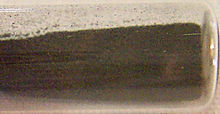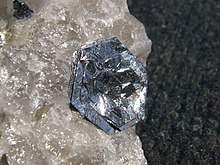Molybdenum
Molybdenum is a chemical element with atomic number 42 that is in group 6 of the periodic table of elements and is symbolized as Mo.
Molybdenum is an essential metal from a biological point of view and is mainly used in alloy steels.
It's a silver metal; it has the sixth highest melting point among the elements. Molybdenum does not occur as a free metal in nature, but rather in various oxidation states in minerals. Industrially, molybdenum compounds are used in high-pressure, high-temperature applications, such as pigments and catalysts.
Most molybdenum compounds have low solubility in water, but the molybdate ion MoO4-2 is soluble and is formed when molybdenum-containing minerals They are in contact with oxygen and water. Some recent theories suggest that the release of oxygen was important in removing molybdenum from a mineral in a soluble form in early oceans, where it was used as a catalyst by single-celled organisms. This sequence may have been important in the history of life, because molybdenum-containing enzymes became the most important catalysts used by some bacteria to break nitrogen molecules into atoms. This, in turn, allowed nitrogen to biologically drive the fertilization of the oceans, and thus the development of more complex organisms.
At least 50 molybdenum-containing enzymes are known in bacteria and animals, although only enzymes from bacteria and cyanobacteria are involved in nitrogen fixation. Due to the diverse functions of the rest of the enzymes, molybdenum is a necessary element for life in higher organisms, although not in all bacteria.
Main features
Physical properties
Molybdenum is a transition metal. This pure metal is silvery-white in color and very hard; Furthermore, it has one of the highest melting points of all the elements. In small amounts, it is used in various steel alloys to harden it or make it more resistant to corrosion. On the other hand, molybdenum is the only metal of the second transition series whose essentiality has been recognized from the biological point of view; it is found in some enzymes with different functions, specifically in oxotransferases (electron transfer function), such as xanthine oxidase, and in nitrogenases (molecular nitrogen fixation function). It is one of the few metals that adequately resist hydrochloric acid., with tantalum being the strongest against this specific corrosive medium. The addition of minimal amounts of metal affect the resistance to hydrochloric solutions that normally affect steels (even stainless steels). Sometimes with a minimum percentage of 2% Mo by mass, the steels acquire the necessary resistance to operate in marine environments. The increase in molybdenum in stainless steels increases its toughness and above all its resistance to attack by chlorine compounds.
In its pure form, the silvery-white metal is molybdenum with a Mohs hardness of 5.5. It has a melting point of 2623 °C. Of the naturally occurring elements, only tantalum, osmium, rhenium, tungsten, and carbon have higher melting points. Molybdenum only oxidizes rapidly at temperatures above 600 °C (weak oxidation begins at 300 °C).. Its coefficient of expansion is one of the lowest among commercially used metals. Its tensile strength causes molybdenum wires to increase from 10 to 30 GPa when its diameter decreases from 50-100 nm to 10 nm.
Chemical Properties
| oxidation States Molybdenum. | |
|---|---|
| −2 | Na2[Mom]2(CO)10] |
| 0 | Mo(CO)6 |
| +1 | Na[C6H6Mo] |
| +2 | MoCl2 |
| +3 | Na3[Mo(CN)]6 |
| +4 | MoS2 |
| +5 | MoCl5 |
| +6 | MoF6 |
Molybdenum is a transition metal with an electronegativity of 1.8 on the Pauling scale and an atomic mass of 95.94 g/mol. It does not react with oxygen or water at room temperature. At elevated temperatures, molybdenum(VI) oxide is formed:
- 2 Mo + 3 O2 → 2 MoO3
Molybdenum has several oxidation states (see table). An example is the instability of molybdenum(III) and tungsten(III) compared to the stability of chromium(III). The oxidation state is most common in molybdenum(VI) (MoO3) while the normal sulfur oxide compound is molybdenum disulfide (MoS2).
Molybdenum (VI) oxide is soluble in bases and contributes to the formation of molybdates (MoO42−). Molybdates are less oxidizing than chromates, but show a similar tendency when they form complex oxoanions by condensation at lower pH values, such as [Mo7O24]6− and [Mo8O26]4−. Polymolybdates can incorporate other ions into their structure, forming polyoxometalates. Phosphorus containing heteropolymolybdate P[Mo12O40]3− is used for spectroscopic detection in phosphorus. The wide range of oxidation states of molybdenum is reflected in various molybdenum chlorides:
- Molybdenum chloride (II) MoCl2 (yellow only)
- Molybdenum chloride (III) MoCl3 (dark red only)
- Molybdenum chloride (IV) MoCl4 (black only)
- Molybdenum chloride (V) MoCl5 (dark green only)
- Molybdenum chloride (VI) MoCl6 (brown only)
The structure of MoCl2 is made up of Mo6Cl84+ is made up of four ions of chloride that tend to balance the electrical charge.
Like chromium and some other transition metals, molybdenum is capable of forming quadruple bonds, as in Mo2(CH3COO)4. This compound can be transformed into Mo2Cl84− which also has a quadruple bond.
Oxidation state 0 is possible with carbon monoxide as a ligand, as in molybdenum hexacarbonyl, Mo(CO)6.
Applications
- Approximately two thirds of the molybdenum consumed are used in alloys. The use of molybdenum dates back to World War I, when there was a strong demand for wolframio, which made it scarce, and very resistant steels were needed. Molybdenum is therefore used in high resistance alloys that support extremely high temperatures and corrosions. These alloys are used in construction and aircraft and automobile parts.
- Molybdenum is used as a catalyst in the oil industry. Specifically, it is useful for the elimination of sulfur. Molybdenum is an important component of high-performance catalysts for selective oxidation of propane, propylene or acrolein in acrylic acid.
- The 99Mo is used in the nuclear isotopes industry.
- It is used in different pigments (with an orange color), for paints, dyes, plastics and rubber compounds.
- Molybdenum Disulfuge (MoS)2) is a good lubricant by itself and provides extreme pressure tolerance properties to lubricants when reacting with metal, so that a crystalline layer is formed on the surface of this. Thanks to this, metal-metal, long-term destructive contact is reduced to a minimum and can be used at high temperatures.
- Molybdenum is used in certain electronic applications, such as in the leading metal layers in the TFT transistors (Thin Film Transistor).
History
Molybdenum is not found free in nature and the compounds that can be found were confused with other compounds of other elements (carbon or lead) until the century XVIII. In 1778 Carl Wilhelm Scheele reacted the mineral molybdenite (MoS2) with nitric acid, obtaining a compound with acidic properties which he called "acidum molybdenae" (The word molybdenum comes from the Greek "molybdos" which means "like lead", since it was confused with this element.) In 1782 Hjelm isolated the impure metal by reducing the previous compound with carbon. Molybdenum was used very little, and only within the laboratory, until the late 19th century, when a company used it as an agent alloying and observed the good properties of these alloys with molybdenum.
For a long time there was no industrial use for molybdenum. The French company Schneider Electric made the first armor from molybdenum steel plates in 1894. Until World War I, most armor factories also used molybdenum alloys. In World War I some British tanks were protected by 75mm manganese plating, but this proved ineffective. The manganese plates were replaced by 25mm molybdenum plates. This change allowed for more speed, and maneuverability. The high demand for molybdenum in the World Wars and the sharp decline after the war had a great influence on molybdenum prices and production.
Abundance and obtaining
The main source of molybdenum is the mineral molybdenite (MoS2). It can also be found in other minerals, such as wulfenite (PbMoO4) and powellite (CaMoO4). Molybdenum is obtained from the mining of its ores and as a by-product of copper mining, the latter being the main mode of commercial exploitation; molybdenum is present in the mines in a range between 0.01 and 0.5%. Approximately half of the world's molybdenum production is located in the United States.
The world's largest producers of molybdenum materials are the United States, China, Chile, Peru, and Canada. Molybdenum is a mined mineral, and is also recovered as a by-product of copper and tungsten mining. Large mining operations in Colorado extract molybdenite as their primary product, while many porphyry copper deposits, such as the Bingham Canyon mine in Utah and the Chuquicamata mine in northern Chile produce molybdenum as a byproduct of copper mining. The Knaben mine in southern Norway opened in 1885, becoming the first molybdenum mine. It remained open until 1973.
Molybdenum is the 54th most abundant element in the Earth's crust and the 25th most abundant element in the oceans, averaging 10 ppm.
Molybdenite is heated to a temperature of 700 °C and the sulfide is oxidized to molybdenum(VI) oxide by air:
- 2 MoS2 + 7 O2 → 2 MoO3 + 4 SO2
Oxidized ore is heated to 1100°C to sublime the oxide, or create leaches with ammonia, which reacts with molybdenum(VI) oxide to form water-soluble molybdates:
- MoO3 + 2 NH4OH → (NH4)2(MoO)4+ H2O
Copper molybdenite is less soluble in ammonia. To completely remove it from solution, it is precipitated with hydrogen sulfide.
Pure molybdenum is produced by reduction of the oxide with hydrogen, while molybdenum used for steel production is reduced by aluminothermic reaction with the addition of iron to produce ferromolybdenum. A common form of ferromolybdenum contains 60% molybdenum.
Molybdenum was valued at approximately $30,000 per ton as of August 2009. It was priced at or near $10,000 per ton between 1997 and 2003, and peaked, due to increased demand, at $103 000 per tonne in June 2005. In 2008, the London Metal Exchange announced that molybdenum is traded as one of the commodities on the exchange.
Source: USGS.
Biological paper
It is the only element of the second transition series whose essentiality has been recognized. Molybdenum occurs in nature in the parts per million (ppm) range. It is found in significant amounts in seawater in the form of molybdates (MoO42-), and can be readily absorbed by living things in this form.
Molybdenum is found in the so-called molybdenum cofactor (moMo) in different oxotransferases, with the function of transferring oxygen atoms from water (H2O) while the transfer occurs of two electrons. Some of the enzymes that contain this cofactor are xanthine oxidase (which oxidizes xanthine to uric acid), aldehyde oxidase (which oxidizes aldehydes, as well as amines and sulfides in the liver), sulfite oxidase (which oxidizes sulfites in the liver), and nitrate reductase (important in the nitrogen cycle in plants).
Biochemistry
Molybdenum in living things is a metal heteroatom in the active site in certain enzymes. In nitrogen fixation in some bacteria, the enzyme nitrogenase is involved in the terminal stage of molecular nitrogen reduction, usually containing molybdenum in its active site (although substitution of Mo with iron or vanadium is also known). The structure of the catalytic center of the enzyme is similar to that of iron-sulfur proteins, which incorporates 2 molecules (Fe4S3 and MoFe3S3).
In 2008, it was reported that the scarcity of molybdenum in the oceans of the early Earth was a limiting factor in the evolution of life for eukaryotes (which includes all plants and animals) as eukaryotes cannot fix nitrogen and must acquire from prokaryotic bacteria. The scarcity of molybdenum results in the relative lack of oxygen in the early ocean. Dissolved oxygen in the sea helps dissolve molybdenum minerals on the seabed. However, although oxygen can promote nitrogen fixation through the uptake of available molybdenum in the water, it also affects the poisons of these nitrogenase enzymes, so organisms that continue to fix nitrogen under aerobic conditions are forced to to isolate their nitrogen-fixing enzymes in heterocysts, or similar structures.
Molybdenum compounds, take various forms as organic molecules (such as carbohydrates and amino acids) and are transported through the human body as MoO42-. At least 50 molybdenum-containing enzymes are known, mainly in bacteria, and their number increases with each year; enzymes include aldehyde oxidase, sulfite oxidase, and xanthine oxidase. In some animals and humans, it catalyzes the oxidation of molybdenum. xanthine to uric acid, a purine catabolism process, by xanthine oxidase, a molybdenum-containing enzyme. Xanthine oxidase activity is directly proportional to the amount of molybdenum in the body. However, a high concentration of molybdenum reverses the trend and can act as an inhibitor, both in purine catabolism and other processes. Molybdenum concentrations also affect protein synthesis, metabolism, and growth.
In animals and plants, these enzymes use molybdenum as a cofactor. All living things that use molybdenum enzymes so far identified in nature use this cofactor, except for nitrogenase, which fixes nitrogen in some bacteria and cyanobacteria. Molybdenum enzymes in plants and animals catalyze oxidation and sometimes reduction of certain small molecules, as part of the regulation of nitrogen, sulfur, and carbon cycles.
Food-deficient humans
The human body contains about 0.07 mg of molybdenum per kilogram of body weight. It occurs in high concentrations in the liver, kidneys, and vertebrae. Molybdenum is also present in the enamel of human teeth and can help prevent deterioration. Pork, lamb, and beef liver each have about 1.5 ppm of molybdenum. Other significant food sources include green beans, eggs, sunflower seeds, wheat flour, lentils, and grains. cereals.
The average daily intake of molybdenum varies between 0.12 and 0.24 mg, but depends on the molybdenum content of food. Acute toxicity has not been seen in humans, and is highly dependent on the state chemical. Although human toxicity data are not available, animal studies have shown that chronic intake of more than 10 mg/day of molybdenum can cause diarrhea, growth retardation, infertility, and low birth weight. It can also affect the lungs, kidneys, and liver. Sodium tungstate is a competitive inhibitor of molybdenum, and its diet reduces the concentration of molybdenum in tissues.
Dietary deficiency of molybdenum from its concentration below the earth's surface has been associated with higher rates of esophageal cancer in parts of China and Iran. Compared to the United States, which has a higher supply of molybdenum in the soil, people living in these areas have an approximately 16-fold increased risk for esophageal squamous cell carcinoma.
Related diseases
A molybdenum cofactor seen in infants kills the body's ability to use molybdenum in enzymes. It causes high levels of sulfite and uric acid, and neurological damage. The cause is the body's inability to synthesize molybdenum cofactor, a molecule that binds to molybdenum heterocyclic chains at the active site of all enzymes. known to use molybdenum.
Antagonism of copper
High levels of molybdenum can interfere with copper absorption, leading to copper deficiency. Molybdenum bypasses plasma copper-binding proteins, and also increases the amount of copper excreted in the urine. Ruminants consuming high amounts of molybdenum show symptoms such as diarrhoea, growth failure, anemia and achromotrichia (loss of hair pigment). These symptoms can be alleviated by administering more copper to the body, both in the form of diet and by injection. The condition can be aggravated by excess sulfur.
Copper reduction or deficiency can also be deliberately induced for therapeutic purposes by the ammonium compound tetrathiomolybdate, where the bright red anion tetrathiomolybdate is the "chelating" coppermade. Tetrathiomolybdate was used for the first time in the treatment of copper toxicosis in animals. It was then that it was introduced as a treatment in Wilson's disease, an inherited disorder of copper metabolism in humans, which acts by both competing copper absorption in the intestine and increasing excretion. It has also been found to have an angiogenesis-inhibiting effect, possibly through copper ion inhibition, in the process of membrane translocation involving a non-classical secretion pathway. This makes it an interesting investigational treatment for cancer, age-related macular degeneration, and other diseases cause excessive deposition of molybdenum in blood vessels.
Isotopes
Molybdenum has six stable isotopes and about two dozen radioisotopes, most with half-lives on the order of seconds. 99Mo is used in 99Mo/99mTc generators for the nuclear isotope industry. It is estimated that this market for 99Tc products moves about 100 million euros per year. These generators are widely used to produce technetium radiopharmaceuticals used in nuclear medicine.
There are 35 known isotopes of molybdenum ranging in atomic mass 83 to 117, as well as four nuclear isomers. Seven isotopes occur naturally, with atomic masses of 92, 94, 95, 96, 97, 98, and 100. Of these naturally occurring isotopes, only molybdenum-92 and molybdenum-100 are unstable. All of the unstable isotopes occur in the isotopes of molybdenum, niobium, technetium and ruthenium.
Molybdenum-98 is the most abundant isotope, representing 24.14% of the total molybdenum. Molybdenum-100 has a half-life of about 1019 years and undergoes a double beta decay to ruthenium-100. Isotopes of molybdenum with mass numbers 111 to 117 have a half-life of approximately 150 ns.
Precautions
Molybdenum fume and dust can be generated by mining or metallurgy, and can be toxic, especially if ingested. Prolonged low levels of exposure may cause eye and skin irritation. Direct inhalation or ingestion of molybdenum and its oxides should be avoided. OSHA specifies the maximum allowable amount of molybdenum exposure in an 8-hour shift as 5 mg/m³. Chronic exposure to 60 to 600 mg/m³ can cause symptoms such as fatigue, headaches, and joint pain.
Contenido relacionado
Barium
Halogens
Deoxyribose


